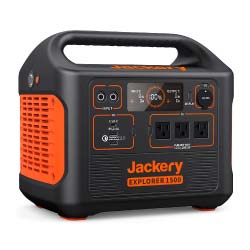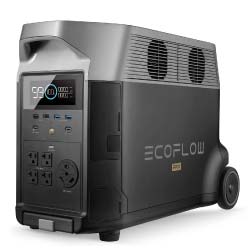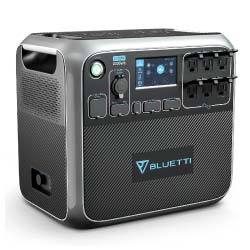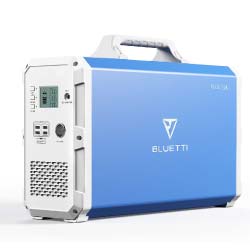Best Solar Generator for Off-Grid Living – [Portable Yet Powerful]
If you want the best solar generator for off-grid living, give a thought to this article, we have listed powerful yet portable machines for you.
Off-grid living and general outdoor activities have always been my favorite things to do whenever I have time.
For that, I need electricity for some basic things like cooking, running my small AC, a fridge, lights, camera, and drone batteries, a cellphone, and a laptop.
So instead of relying on a noisy portable generator and solar system, I found off-grid solar generators to be much more reliable for proper off-grid living and even in emergencies. Being a hustler, I appreciate the overall ease of use.
I am a huge advocate for solar generators because they are not only portable, compact, and lightweight, but they also have multiple charging options, they are not noisy, and they can generate as much as 3000W rated watts (Ecoflow Delta Pro).
Since I am an engineer, I took it upon myself to find a couple of solar generators that are just about perfect for off-grid ventures.
I have also looked into all the factors that are necessary before making a purchasing decision. So without waiting, let’s get to the reviews.
RECOMMENDED BY EXPERTS



1. Ecoflow Delta Pro – Best Solar Generator for Off-Grid Living
FEATURES & SPECS

If there is any power station worthy of calling a true off-grid solar generator, Ecoflow delta pro is the one.
This thing delivers a solid 3600 rated watts, and 7200 starting watts with a 3.6KWh battery capacity.
A couple of months ago, I switched 70% of the power of my off-grid cabin to Ecoflow delta pro and two battery packs. Now, I have reduced some appliances and have switched 90% load on Ecoflow.
The reason it is preferred for off-grid is that it cannot only power at 120V but it can also be operated at 240V to power heavy-duty appliances like a dryer.
If you connect two Ecoflow delta pros, you will get a whopping 7200 running watts. Connect two battery expansion packs with Delta Pro, you will get 10800W which is enough to run an off-grid cabin in the woods.
Based on my multiple tests, I found that the inverter is 93% efficient which is crazy good. Anything above 90 is gold.
Though this power station is rated at 3600W, with X-BOOST technology, we can get as much as 4500 rated watts for a short time like other Ecoflow variants.
As far as the design goes, it weighs only 99 pounds which is excellent weight management for a 3.6KWh battery capacity. The built quality is excellent. There are no loopholes.
It is built like a PC with 12 x 11.2 x 16.4 inches in dimensions. So far, I don’t have any trouble managing space for this one.
The cables and dual-AC hub that come with the package are of supreme quality.
It got an LCD control panel that shows input and outgoing power, output power from 12V receptacles, battery stats, and error codes. An ambient light detector on the LCD automatically adjusts the lighting.
This thing is absolutely loaded with different ports so that you can practically run anything whether heavy-duty or 12V appliance in your off-grid cabin or house. It has the following outlets:
| Outlets and ports of Ecoflow delta pro |
|---|
| X2 USB-A fast charging ports |
| X2 USB-A ports |
| X2 USB-C 100W ports |
| X5 AC output outlets |
| Solar Charging Input |
| One Anderson power port |
| Car outlet |
| AC Charging Input |
So there are multiple ways you can charge this power station. Using 1600W solar input, it will take 6.7 hours to fully charge.
Using 1800W of solar input through fast charging technology, it will take 2.7 hours to fully charge.
If you are close to an electric vehicle charging station, Ecoflow delta pro can take 3000W of input which will take no time to fully charge.
I have tried all methods and I am more satisfied with all of them. I am only using solar charging for delta pro and battery expansion for now because my cabin is completely off-grid.
Speaking of the battery expansions, the main benefit is not the added 7200W into Delta pro, but both battery packs will charge and discharge together with the power station.
If delta pro and one battery pack are at 50% charging, and the second battery pack is at 40%, then one with the 40% will charge up to 50%, then all three charge together.
Based on my load test, this power station was able to deliver an average of 3615 running watts. It delivers more than advertised.
If I talk about its performance for off-grid, I regularly use the following appliances off of Delta pro along with two battery packs.
| Appliance | Peak watts | Running watts |
|---|---|---|
| A standard fridge | 1200 | 200 |
| Microwave oven | 1000 | 1000 |
| Coffee maker | 600 | 600 |
| Electric blanket | 200 | 200 |
| Computer | 250 | 250 |
| Incandescent lights | 300 | 300 |
| Sump Pump | 800 | 1500 to 300 |
| Well pump | 1000 | 2000 |
| Circular saw | 1400 | 2300 |
| Electric drill | 600 | 600 |
| Portable air compressor ½ HP | 1000 | 1600 |
| Chainsaw | 1500 | 1500 |
| Bench grinder | 1400 | 2500 |
So far I don’t have any issues even if I run 240V appliances. I would 100% recommend this unit even if it is a bit expensive. I will say it again that Ecoflow Delta Pro is a solar generator for off-grid living.
RATINGS: 9.5/10
Checkout complete Review of Ecoflow delta pro
2. Bluetti AC200P- Best Portable Solar Generator for Off-Grid Living
FEATURES & SPECS

During my first review of Bluetti AC200P after 11 months of usage, I am writing another one after using it for 2 months for complete off-grid living.
This power station is specially designed for camping, Overlanding, and general outdoor living with keeping fast charging and high power output in mind.
This unit has been able to power my daily life essentials like cellphones, laptops, cameras, coffee makers, small AC, a mini-fridge, a small TV, and a few other appliances.
One of the main selling points of Bluetti AC200P for off-grid is 4800 surge watts along with 2000 rated watts.
One of the main selling points of Bluetti AC200P for off-grid is 4800 surge watts along with 2000 rated watts. To run large motor-driven devices at a time like refrigerators (Checkout our recommended solar generators for refrigerators) and ACs, 4800 watts surge comes in handy.
This little bad boy has ECO-mode to save battery, LifePO4 battery composition, and a touch screen panel to play with settings.
The LCD panel shows input and output, temperature, battery stats, current, voltage, etc.
Speaking of design, it is built like a small radio and is made of super durable hard plastic and it is compact in dimensions (16.5 x 11 x 15.2 inches).
Bluetti AC200 weighs 27.5kgs which is a bit heavy but it is equipped with a 2000Wh battery so that’s kinda understandable.
This power station is loaded with various ports
- X6 110V AC ports.
- X1 12V 10A DC.
- X1 12V 25A DC.
- X1 12 3A DC.
- X4 USB A outlets.
- X1 USB C port.
- 2 wireless charging ports.
- X1 PD 6OW fast charger outlet that accepts 5V/3A, 9V/3A, 12V/3A, 15V/3A, and 20V/3A charging
There are multiple ways you can charge this unit. I have tried the following methods.
- 700W solar input, 3.6 hours to fully charge
- Using dual-AC adapter – 2.5 to 3 hours to fully charge
- Solar + wall: 411W AC and 650W solar, the device took 2.5 hours to fully charge
- AC/generator: The device took 4.6 hours to fully charge
- Car charging: 8.9 hours to fully charge using a 24V car outlet.
Above mentioned charging, times are based on my personal experience.
If I talk about its performance, I have been able to run the following appliances.
| Appliance | Watts |
|---|---|
| Microwave | 1000 – 2000 |
| Coffee Maker | 600 – 1200 |
| Toaster | 800 – 1500 |
| Fridge | 400 – 700 |
| Laptop and computers | 20 – 75 |
| Speakers | 200 |
| TV (50” LED) | 240 |
I have also tested how many charges it will provide for the following appliances:
- Cellphone = 170 to 180 charges
- Laptop = 25 to 30 charges
- Mini fridge = 25 to 28 hours
- TV = 15 to 20 hours
- 100W projector = 15 to 20 hours
- 8000BTU AC = 5 to 7 hours
- Coffee maker = 5 to 70 hours
- Hair dryer = 70 to 75 minutes
The power efficiency of Bluetti AC200P is close to 88% which is superb for a big unit. During my off-grid venture, I have been able to run my drones, camera batteries, survival equipment, small AC, and a few other appliances without any issues.
I like the 15W wireless charging pad as well. It will only take 2 to 2.2 hours to fully charge a cell phone.
During my initial 11 months of usage, I conducted a load test and the power station was able to reach 2010-rated watts before the overload alarm.
I was super impressed by the overall power efficiency and true power output. The only problem I see is the inefficient BMS. If you leave it overnight, the BMS will drain a ton of battery percentage just to stay ON.
I heard that Bluetti has improved the BMS in their latest AC200P models. I hope this is true.
RATINGS: 9/10
Checkout complete Review of Bluetti AC200P
3. Jackery Explorer 1500 Off-Grid Solar Generator
FEATURES & SPECS

Instead of adding the outstanding Jackery 1000 to this list, I have decided to recommend the Jackery explorer 1500 which has 50% more battery capacity, and 80% more power than Jackey 1000.
This power station is one of the most fantastic power stations for off-grid due to its simple plug-play style, and user-friendly interface.
This device can run at 120V as well if needed which is a bonus if you are living in a small cabin in the woods.
One of the biggest improvements made in this unit is that it only takes 4 hours to charge instead of 8 to 9 hours as we have seen with explorer 500 and 1000.
All the cables needed for the charging are provided with the package and the quality of the accessories is just elite.
The design and built quality are the same as other Jackeries. There are no loose ends, everything feels like upper-class level construction with this unit.
Jackery explorer 1500 weighs only 15Kgs and it is compact and portable in dimensions.
For off-grid use, it is equipped with a massive 1534Wh battery and the unit delivers 1800 rated watts. It is also equipped with a high-quality BMS that doesn’t each much battery to stay ON. It has a nice LCD as well.
The only problem I have with the design is the limited choice of USB-A and USB-C ports.
I would’ve loved a bit more outlets to charge and power multiple appliances like cellphones, laptops, camera batteries, drone batteries, a coffee maker, an electric stove, and other off-grid items.
There are three ways you can charge this unit. Using two AC charging bricks, you will get 500W input power which charges the unit in 3.1 hours to 100%.
Using 400W input from SolarSaga panels, the device will charge up to 100% in 4.2 hours.
From the 12V car output, it will 13 hours to fully charge Jackery explorer 1500 to 100%.
Based on my load test, Jackery 1500 was able to deliver 1989W rated before the overload alarm. These Jackery units are expensive for a reason.
As far as performance is concerned, Explorer 1500 will be able to run the following things:
| Appliances | Runtime |
|---|---|
| Mini-cooler | 21.4 hours |
| PS4 console | 63 hours |
| Coffee maker | 71 minutes |
| Electric stove | 67 minutes |
| Microwave Oven | 65 minutes |
| RV refrigerator | 18 hours |
| TV | 22 hours |
Moreover, I have used this device at the extreme temperature (-5C) without any problem. The unit is fairly quiet. The fan only kicks ON when the load is higher than expected.
The biggest selling point of Jackery 1500 for off-grid use is the reliability and durability it brings to the table. It is like the iPhone of solar power stations.
The only problem I see is that Jackery will not allow you to use your solar panels. It will accept SolarSaga panels unless you are a DIY guy. For the price point, it sucks.
RATINGS: 8.5/10
Checkout complete Review of Jackery Explorer 1500
4. Maxoak Bluetti EB240 Solar Generator
FEATURES & SPECS

Maxoak Bluetti EB240 is the elder brother of EB150 with a massive 2400Wh battery capacity. This unit is designed keeping off-grid use in mind.
If you don’t have a solar system for your cabin or RV (Checkout our recommended solar generators for RV), Bluetti EB240 can fulfill your energy needs without any problem. I have also written a full review of Bluetti EB240. This is going to be a summary.
So this is a self-contained power station with multiple charging options. The built quality is excellent and it can easily withstand the abuse of the road.
The ports are 12.1 regulated. You may have heard the rumors about the inefficiency of the inverter, but I have tested it and the inverter is more than 80% efficient.
Maxoak Bluetti EB240 delivers as much power as two battle-born batteries at a cheaper price. So the cost per watt is really good and affordable.
The design is solid. It is surrounded by an aluminum casing. It looks exactly like a suitcase with a nice carrying handle. EB240 is portable and compact, it doesn’t take up much space.
It weighs 48.5 pounds which is a bit heavy for some but considering the huge 2400Wh battery capacity, the weight is fine for me.
There are separate buttons for AC/DC power output which is good. There are the following ports on the control panel:
- X2 AC ports = 110V
- X1 DC ports = 12V 9A
- X1 PD USB-C port = 45W
- X4 USB-A ports = 5V 3A
I wouldn’t mind some extra USB-C ports. Bluetti needs to look into this.
So there are multiple ways you can charge this unit. Using an AC 200W adapter, Bluetti EB240 took around 14.6 hours to fully charge which is dull if you ask me.
I understand it is made for off-grid use and it is only equipped with a 1000W inverter, but at least 400W AC input was needed.
This solar generator is also equipped with a modern MPPT charge controller that increases the solar charging speed up to 40%. They also provide a standard MC4 connector.
If you give it 500W solar input, EB240 will take 5 to 5.5 hours to fully charge. I had only 300W of input during the time of the test, so mine took 8.4 hours.
Based on my tests, Maxoak Bluetti EB240 offers the following amount of charges for a variety of appliances.
- Laptop (60Wh) = 33 charges
- Cellphone (30Wh) = 254 charges
- CPAP machine = 30+ hours
- LED lights (10W) = 200+ hours
- WIFI router = 30 hours
- A 250W blender = 7+ hours
- Microwave (600W) = 3+ hours
Moreover, this unit was able to run a standard home fridge, and a 15A table saw for a few moments.
Firstly, to address the rumors about the inefficiency of EB240’s inverter, I conducted a capacity test of my own where I was able to get 2080W at 100W load at 12.1V. It took 20 hours to discharge. The result was 86.6% inverter efficiency.
Secondly, for the load test, I pulled exactly 10Amps from the 12V ports. Lastly, I was able to get 1190W for 3 minutes and 11 seconds. The claim was it can go for 1200W for 3 minutes.
It passed all the tests with flying colors.
Maxoak Bluetti EB240’s battery cells offer three times the life compared to Jackery and they cost less per watt, and they have packed all that 2400Wh capacity in a tiny body.
So this thing was able to power my 5000 BTU AC for 3.5 hours. If you can manage to give it a constant 500W solar feed, it will be able to run for an entire day.
This power station can handle three panels in a series whereas Bluetti EB150 could handle only two.
This power station is good in power, design, versatility, and reliability. The only complaint I have is the inverter size. It could’ve been a top dog in the market if it would have a 1500 or 1600W inverter.
Other than that, I would recommend it if you are looking for a portable off-grid solar generator.
RATINGS: 8.5/10
Checkout complete Review of Maxoak Bluetti EB240
What Size Generator Do I Need for Off-Grid Living?
While the size of the off-grid generator required for off-grid depends on your needs, anything between 400Wh to 2000Wh capacity is considered a standard based on my experience.
If you need the power to run a mini-fridge small, for cooking, and for coffee makers, then consider purchasing a solar generator in the 1000Wh to 2000Wh range.
How to Find the Best Solar Generators for Off-Grid Living
A few things should be considered before purchasing a solar generator specifically for off-grid use.
Capacity:
For portable generators, we have the option of bringing propane and gasoline with us, but for the power stations, you don’t have the dual-fuel option. So choosing the right battery capacity that is measured in Watt-hours is very important.
To give you another example:
Solar panel power is measured in watts and a watt is equal to a volt multiplied by an amp.
The following devices are mostly used on a camping trip.
| Device | Amps | Hours | Amp Hours (12v) |
|---|---|---|---|
| Mini-Fridge | 4 | 14 | 56 |
| LED lights | 0.5 | 8 | 4 |
| Phone Charger | 2 | 3 | 6 |
| Laptop | 2 | 7 | 14 |
| Total | 80Ah |
Now suppose you have a 150Ah battery and all of the devices are 12V.
80Ah x 12V = 960Wh (A x V = W)
This much battery capacity is required to run the above-mentioned devices for mentioned hours, but this is theoretical. Practically, we add 20% extra power to the calculation to cover the energy losses.
960Wh + 20% extra power = 1152Wh
Power Output:
Ideally, anything between 600W to 100W is fine for Rving, Overlanding, and dry camping, but if you want to go on a full-time off-grid cabin type of living, then anything in the range of 1500W to 2500W would be good.
If you want a bulletproof plan, you would need to calculate the power of the appliances you are going to run.
For example:
The formula to calculate watts is:
Watts = Volts x Amps
Suppose:
Your refrigerator’s label in your off-grid cabin is saying 5 amps and 120V.
Watts = Volts x Amps
= 5 x 120 = 600 watts.
The following things might help you to calculate the power consumption of your house.
If the total wattage consumption of your camper is 800 watts, get a solar generator rated at 1200.
Common appliances used in off-grid cabins.
| Appliances | Running Watts | Starting Watts |
|---|---|---|
| Window air conditioner | 1,200 | 1,800 |
| Electric blanket | 200 | 200 |
| Dehumidifier | 240 | 240 |
| Space heater | 600 to 1,500 | 600 to 1,500 |
| Vacuum | 300 | 500 – 600 |
| Coffee maker | 800 – 1000 | 1000 – 1200 |
| Electric pressure cooker | 1000 | 1000 |
| Toaster | 850 | 900 – 1000 |
| Dishwasher | 350 | 400 – 500 |
| Electric stove | 1,500 | No surge requirement |
Size and Shape:
Space management is one of the most important skills for an outdoorsman. Even if you own an off-grid cabin, you don’t drag around a heavy-ass solar generator.
If you are still new to camping and outdoor life, make it a hard and fast rule not to bring anything heavy with you. Trust me it will become a burden down the road.
The bigger the capacity, the bigger the generator is not always necessary. Units like Bluetti EB240 are super compact while holding a massive 2400Wh capacity.
Ideally, anything below 45 pounds is a good choice. Look for something ergonomic with a carry handle and a low center of gravity. It won’t fall while driving on a rough road.

Alex Black is a seasoned electrical engineer with a remarkable 8-year track record specializing in appliances, generators, and transfer switches. With extensive hands-on experience in the field, Alex possesses a deep understanding of electrical systems and their intricate workings. Throughout their career, Alex has consistently demonstrated expertise in designing, troubleshooting, and maintaining various electrical appliances.
